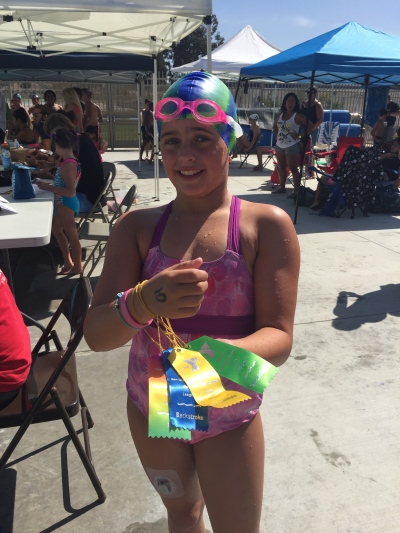A few weeks ago I posted this bragging picture on Twitter
I was very pleased with how we rocked BG management during V’s swim team practice, when she’s prone to going low. On a surface, it took a few simple steps: check BG, tweak insulin dosage a little and give her a snack. But come backstage with me. I will give you an exclusive tour of what it took on that particular day to get such a stellar outcome.
4:30 PM
I pick up V from school and we are driving to the YMCA. She checks her BG; it’s 216. “The pump recommends 1.65 units of insulin for correction”, she says. I mull it over and we talk about options. V is hungry and she typically has a snack before swim – usually a protein bar. If she boluses for her snack, she will have a lot of active insulin in her body when she is swimming and she will definitely go low. If she does not bolus for a snack, she may get too high and stay high. We haven’t yet pinpointed exactly what the threshold is.
I ask V to check if she already has any insulin onboard (active insulin in her body from a previous dose). She checks her pump and says that she does not. I ask her to look at her CGM and tell me what the trend is. CGM tells us BG is holding steady.
“What are you going to eat?” Normally I pack something but that day I completely forgot. I offer to buy her something when we get to the YMCA.
“Chips!”
“Yeah, right. No way. You need to have something that’s a mix of carbs and protein. How about chocolate milk?”
After some back and forth we settle on a yogurt, which is about 20-25g. of carbs.
“OK, let’s do this. Give yourself 1 unit. Don’t bolus for a snack.”
“But the pump says 1.65 units.”
“No, give 1 unit only. One unit brings you down about 60 points. (This is knows as correction factor and is different for every individual; V’s happens to be 60 points to one unit of insulin.) 216-60 = 156. It would be great to stabilize you there. The snack should help sustain your BG during exercise.”
V gives herself 1 unit of insulin and we keep on driving.
4:55 PM
We are at the YMCA. V quickly eats her snack. I glance at the CGM, she is still around 200 and steady. I have a spidey sense about it, I know she will go low even if she had a snack. I temporarily cut her basal (background) insulin rate by half for an hour.
5:00 PM
V starts her swim team practice.
5:30 PM
A routine check half-way through her practice. She is 98. Not bad but not great. Think about it: she started at about 200 and had a good snack. Half an hour later she is 100 points lower. She has 30 more minutes of intense practice and another 30 minutes of a private lesson. I give her a couple of glucose tabs to prevent her from dropping.
6:30 PM
V is done and wants to take a shower. She tests and is 82. Not bad. However, she says she is feeling borderline low. Or maybe she is really tired after 1.5 hrs of intense swimming? I ask her to sit it out for 15 minutes and re-test, and I have a spidey sense that her BG will level out and be OK.
6:45 PM
V says she is feeling well. She tests and gets a 53. What? Re-test, and now she is 85. We deem it to be an accurate number and I clear her to get in the shower.
7:00 PM
V gets out of the shower and CGM displays a perfect 100! She gets dressed and we head home.
7:40 PM
V tests before dinner. 103. We win at diabetes for once!



